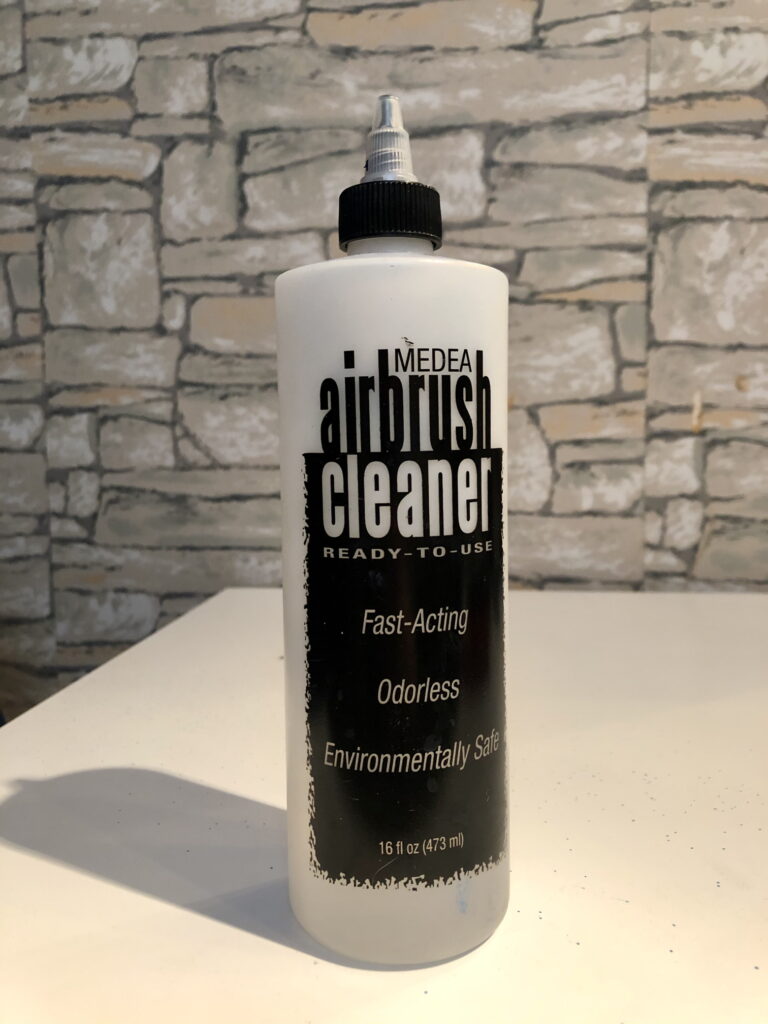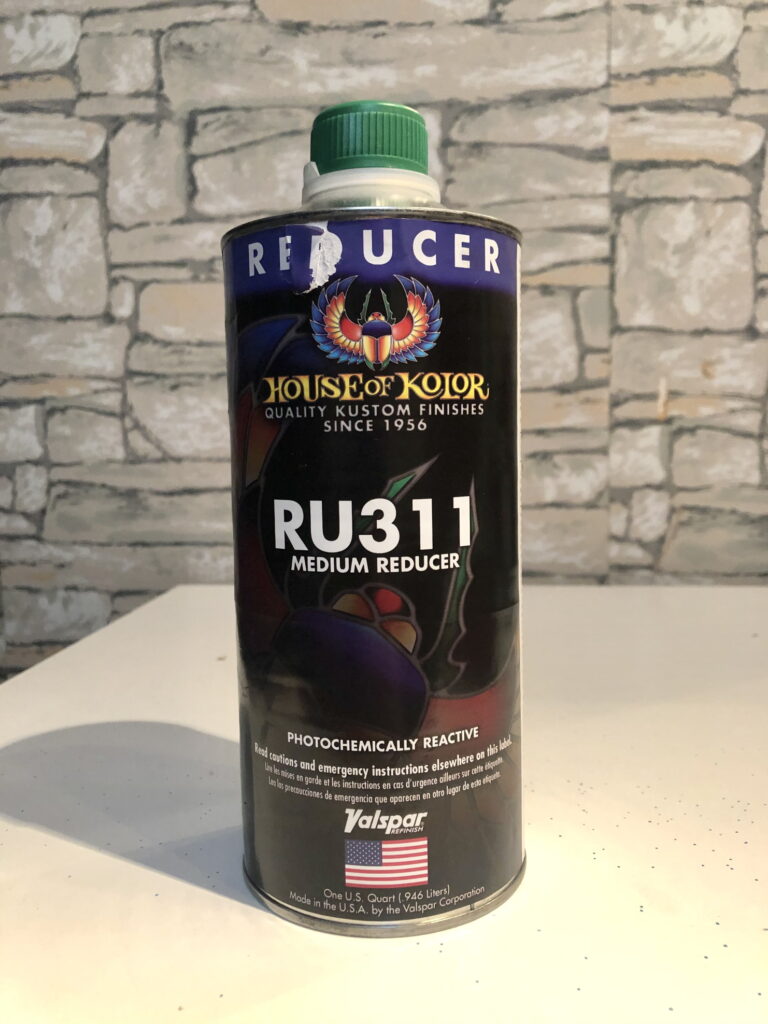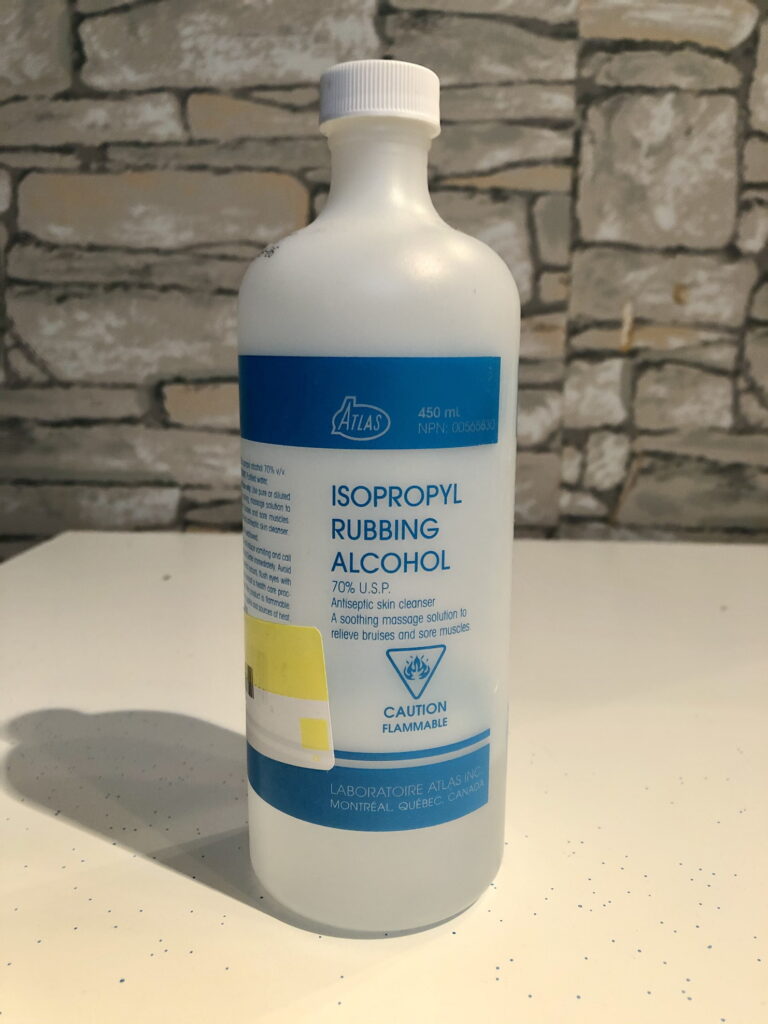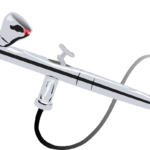There’s nothing like a gunked up airbrush to make you want to pull your hair out. Over my 7 years of airbrushing and body painting experience, I’ve learned that you’re only as good as your airbrush is working. That’s why I put together this short guide on the best airbrush cleaners. My hope is that you spend less frustrated evenings trying to unplug stubborn paint blockages, and spend more time gracing your canvas with smooth, uninterrupted paint flow.
The trick is to get the right airbrush cleaner for the paint you’re using.
Here’s the most common types of airbrush paint:
- Water Based Acrylic
- Urethane or polyurethane
- Alcohol
Best Airbrush Cleaner for Water-Based Acrylic Paint
For water-based airbrush paints, a mild solvent is enough. That’s why I recommend using Iwata-Medea Airbrush Cleaner. This cleaner is a slightly basic solution that is strong enough to dissolve dry acrylic paints but mild enough that it won’t break down your airbrush. It’s relatively cheap, so you don’t have to feel guilty about using a lot of this stuff.
If you do tons of water-based acrylic airbrushing, a bottle of Iwata-Medea Airbrush Cleaner will be the easiest way to clean between colors or unclog pesky tip blockages.
You can either use it straight, or dilute it with water depending on the strength you need. For example, for switching between colors, you can keep a bucket of water and airbrush cleaner solution next to your setup – just dunk the hopper, nozzle, and front tip section into the solution, swish it around and wipe it off with a dry rag for a pretty good clean.
However, after using wash bucket dunk method between colors a few times, you’ll find that you’ll need a deeper clean to get the stubborn dry paint bits.
For the deep clean, squirt a little bit of straight Iwata-Medea Airbrush Cleaner into the hopper. The undiluted cleaner is usually enough to dissolve dried paint and save you time on unnecessary picking and scraping.
Versatility, reliability, and top value are all reasons why I can’t recommend this airbrush cleaner enough – it just works.
Best Airbrush Cleaner for Urethane Based Paint
For urethane or polyurethane based paint, you will need an airbrush cleaner that is also urethane based. This means that water-based airbrush cleaners wont mix with the paint and will just make a gunky mess.
I recommend getting a urethane-based reducer – this will really dissolve the dry paint bits and keep your paint channels clear and free.
A great urethane reducer that I have used over the years is House of Kolor Ru311 Medium Reducer.
Airbrush paint manufacturers often recommend that you get a reducer that is associated with your airbrush paint. Their reasoning is that the molecular construction of the solvent will match the paint and will allow them to blend optimally.
This makes sense to me, and I will admit that automotive painting is slightly out of my expertise as urethane solvent and paint solutions start to get complicated. For information on automotive airbrush painting, check out this guide from Coast Airbrush.
However, for the projects that I’ve done with urethane-based paint, the House of Kolor Ru311 Medium Reducer has always done the trick for me and dissolved any kind of urethane-based paint I threw at it.
The bonus is that this really is just a great reducer to manage paint thickness. For a do-it-all, urethane-based airbrush paint cleaner, get the House of Kolor Ru311 Medium Reducer.
Best Airbrush Cleaner for Alcohol Based Paint
Alcohol based paints are miscible with water. This makes them relatively easy to clean. However, they are most common in temporary tattoo style paints. this means that non-toxic cleaning options are a high priority.
As a body painting artist of seven years, I can attest to the customer’s concern for safety and environmental friendliness. If you’re doing temporary tattoo airbrushing, don’t get a funky smelling solvent with questionable safety properties. There is no need and your customer’s trust is a top priority.
This makes Iwata-Medea Airbrush Cleaner a great option. It’s non-toxic, dissolves alcohol-based paint, and it just gets the job done.
However, I think it’s worth mentioning a great second option – isopropyl alcohol. Straight alcohol-based solvents will help clean stubborn paint bits so it won’t hurt to have a bottle along with you just in case.
The bottles of isopropyl that you can buy from your local drug store will work just fine, but keep in mind that isopropyl alcohol can break down the rings in your airbrush over time. Therefore, you should just use it on individual components and rinse well after cleaning.
With this being said, don’t be too concerned with wrecking the o-rings in your airbrush. If you have an Iwata Medea airbrush like the Eclipse HP-CS, your o-rings are nylon based and resistant to many of the solvents that used to wreak havoc on airbrush components.
Although some people recommend using isopropyl alcohol to clean water-based acrylics as well, I have found that this method kind of makes a goopy solution that can further clog your airbrush. This is why I recommend to only use isopropyl alcohol sparingly, and only on alcohol-based paints.
My recommendation is to use Iwata-Medea Airbrush Cleaner whenever possible, and have a bottle of isopropyl alcohol for backup. A prepared airbrush artist is a happy airbrush artist!
What NOT to use as an Airbrush Cleaner
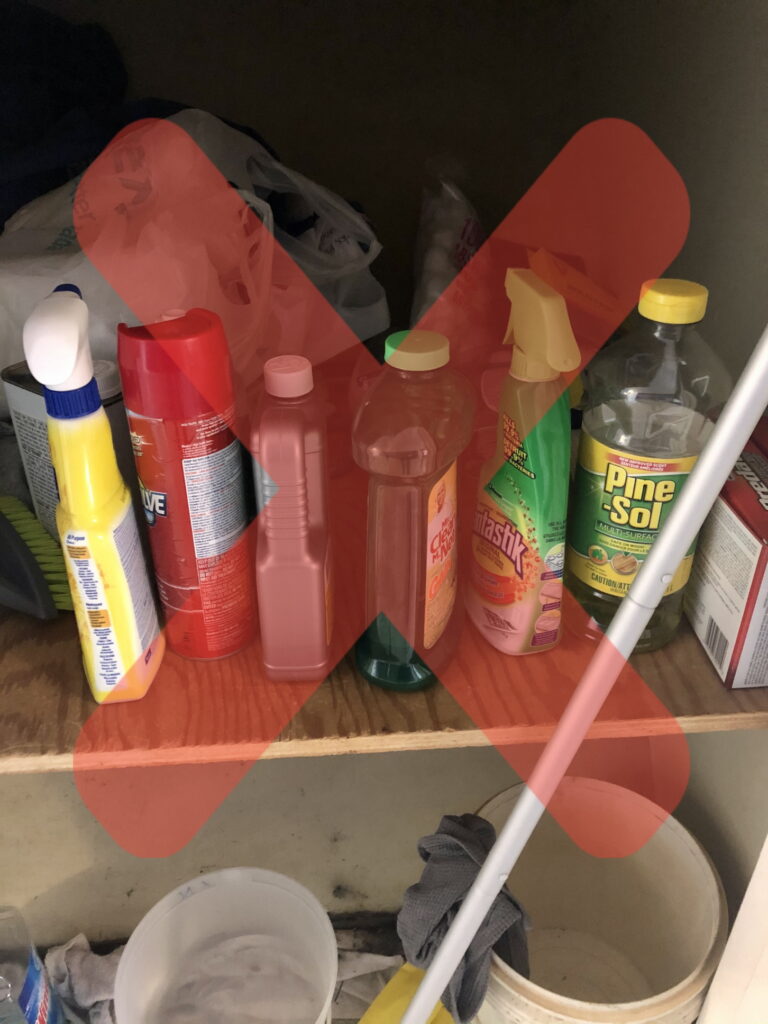
Don’t use ammonia based chemicals (such as windex) to clean your airbrush. They are supposed to break down your o-rings and take the varnish off of your airbrush.
This is a contentious topic because many airbrush artists swear by homemade windex solutions (and apparently windex has non-ammonia solutions available as well).
However, my reasoning is that if you can find milder options that work (like the ones listed in this article), there is no need to risk damaging your airbrush.
With that being said, where most people run into issues with breaking down their airbrush components is when they soak their airbrush in harsh cleaners or otherwise unnecessarily expose their airbrush components to harsh cleaners.
So my recommendation is to never soak your airbrush in any kind of cleaner and only do so with clean water temporarily.
One more thing to avoid when cleaning your airbrush is scraping and prodding with a metal tool. Metal on metal risks creating little scrapes that make a nice rough surface for dried paint to bind. This leads to more paint build up that will be harder to clean next time. It’s a nasty cycle that makes cleaning your airbrush a real headache.
Instead, get the right airbrush cleaner for the kind of paint you’re using! I also recommended in another article about the best airbrush equipment to use toothpicks for cleaning, so you don’t scrape your airbrush.
The best kind of airbrush cleaners are made for the kind of paint you’re spraying, just harsh enough to dissolve dry paint, but gentle enough not to damage your airbrush. My first pick for airbrush cleaners is Iwata-Medea Airbrush Cleaner because it works great for water based and alcohol based airbrush paint. For urethane-based paint, a great reducer like the House of Kolor Ru311 Medium Reducer will serve you well.
Cleaning is a central part to keeping your airbrush working in tip-top condition. Hopefully the information is this article will save you some of the headache that clogged airbrushes have caused me over the years. If you have any questions about how to clean your airbrush, please leave a comment and I would be happy to help!
Until next time, keep painting!

